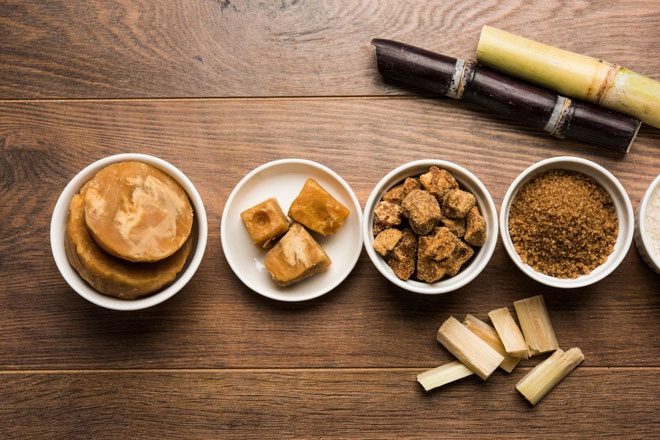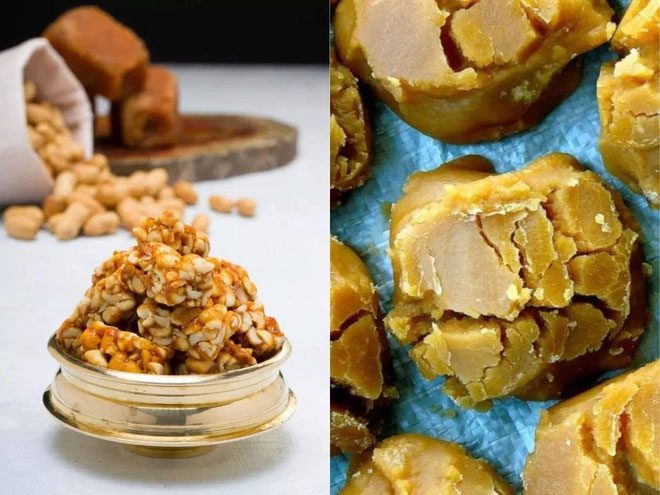Jaggery is rich in vitamins and antioxidants that not only alleviate coughs and sore throats, support digestion, but also boost immunity.
Jaggery, also known as medicinal sugar, is a common ingredient in sweet dishes across India. This sugar is widely available in wholesale markets throughout major cities. India produces over 70% of the world’s jaggery.
Additionally, many South Asian and African dishes also use jaggery, but it goes by various names around the world, such as muscovado (Portugal), panela (Colombia), kokuto (Japan), and rapadura (Brazil).
Jaggery is believed to have been introduced to the Indian subcontinent around 6000 BCE through the Malay Peninsula, located between present-day Southern Thailand and Singapore. It is used in both sweet and savory dishes.

Jaggery is widely used in Indian street food. (Photo: South China Morning Post).
Benefits for Certain Minor Ailments
Jaggery is made from sugarcane grown in rural India. After harvesting, the sugarcane is crushed to extract juice and simmered in large vats until it thickens. Once impurities are removed, the golden liquid is poured into round molds.
After solidifying, it is sold in block or powdered form for about $1/kg. Online stores sell jaggery in various forms and products such as cookies, sugar-coated nuts, and candies.
Nutritionists indicate that jaggery is packed with antioxidants, vitamins, and minerals that can help enhance strength and immunity. At the same time, it may also prevent certain minor ailments.
Jaggery is a healthier alternative to refined sugar. This is why Ayurvedic practitioners incorporate it into many traditional Indian medicines and healing methods.
“Jaggery has a ‘warming’ property, which warms the body. Combining it with ginger and basil leaves can help heal sore throats, seasonal flu, colds, coughs, and fevers,” said Bharti Raghav, an Ayurvedic practitioner in New Delhi.
Ms. Raghav added: “Due to its anti-inflammatory properties, consuming jaggery, ghee, and ginger daily helps reduce joint pain and improves bone health.”
Ms. Raghav noted that jaggery also provides energy as it contains healthy carbohydrates. In rural areas, women use it to relieve menstrual cramps or expedite labor. Additionally, infants and weak children can consume it.
According to Urvashi Agarwal, a holistic health coach in Uttar Pradesh, Northern India, jaggery contains iron, folate (the natural form of vitamin B9), and other essential components, making it useful as a blood purifier and improving hemoglobin levels.
She stated: “It enhances oxygen supply to the brain while boosting brain function and stimulating the secretion of digestive enzymes to aid food digestion.”
Ms. Agarwal added that another reason to consume jaggery is its abundant folic acid and iron content, which can help prevent anemia, a common issue among women in poorer countries.
“Jaggery also contains selenium and zinc as well as antioxidants, all of which help enhance immunity,” she said.
Western studies highlight the health benefits of jaggery. A 2020 review in the Journal of Pharmacognosy and Phytochemistry noted that regular consumption of jaggery can support digestion, aid liver detoxification, reduce constipation and stress, boost energy, and treat premenstrual syndrome. Moreover, studies indicate that jaggery also possesses antioxidant properties and may have anti-cancer effects.
A Part of Indian Culture
Thus, jaggery has become an indispensable part of Indian cuisine for centuries. Grandmothers in India are famous for their jaggery rice cooked slowly with nuts and raisins until the entire kitchen is filled with an irresistible aroma.
Hot chapatis mixed with melted jaggery are considered a delicious dish throughout rural India. Modern chefs incorporate it into puddings, pancakes, dips, pastries, and breads.
Vivek Rana, the head chef at Claridges Hotel in New Delhi, stated that his kitchen uses more jaggery than refined sugar not only to enhance the flavor of dishes, especially desserts, but also to make them easier to digest.

Jaggery aids in better digestion of dishes. (Photo: Navbharat Times).
“Dishes made with jaggery, such as rice cakes, sweet bread, and jalebi, are very popular with our guests. Even in Thai cuisine, we use jaggery for salads like som tam (green papaya salad) and sauces,” Mr. Rana said.
Jaggery can also be used at home to treat common ailments as Mr. Raghav described.
Adil Parikh, a teacher in Mumbai, mentioned that he enjoys sucking on a piece of jaggery after dinner “instead of high-calorie desserts.”
Famous Bollywood actress Shilpa Shetty is also a fan of this sugar. “Jaggery, known as gur in Hindi, is a popular natural sweetener used as a substitute for sugar,” she wrote on her Instagram, which has over 28 million followers.
She added that gur contains no fat, so “you can easily incorporate it into your diet.”
Indian actor Sonu Sood, who loves jaggery, gave his 17 million Instagram followers a tour of a jaggery factory from his village in Punjab, Northern India.
Despite its many beneficial properties, nutritionists warn against excessive consumption of jaggery. Mr. Raghav said: “We should not consume more than 15-20g of jaggery per day. Especially, diabetic patients need to be more cautious, as it is still sugar, even though it is a healthier type.”



















































